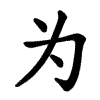为-order
This image is part of the “CJK Stroke Order Project” (en, de, ja, zh), a project on Wikimedia Commons to create a complete set of images depicting the right stroke order (protocols).
The 214 Kangxi radicals have been completed by hand. The next goal is to complete the missing animations from the page GIF progress, help is welcome (official guidelines).
For shape and stroke order :
 Taiwan (ROC): 常用國字標準字體筆順手冊 (Stroke order 14 rules), by the Taiwan Ministry of Education. ISBN 957-00-7082-X (Authoritative, available online)
Taiwan (ROC): 常用國字標準字體筆順手冊 (Stroke order 14 rules), by the Taiwan Ministry of Education. ISBN 957-00-7082-X (Authoritative, available online) China (PRC): 现代汉语通用字笔顺规范, 453pages, 1997, editeur: 语文出版社, ISBN:7801262018 (Authoritative, available online)
China (PRC): 现代汉语通用字笔顺规范, 453pages, 1997, editeur: 语文出版社, ISBN:7801262018 (Authoritative, available online) Japan : 筆順指導の手びき (Hitsujun shidō no tebiki), 1958. Note: Since 1977, the Japanese Ministry of Education recommend to publishers to simply « follow commonsensical [strokes] orders which are widely accepted in the society ».
Japan : 筆順指導の手びき (Hitsujun shidō no tebiki), 1958. Note: Since 1977, the Japanese Ministry of Education recommend to publishers to simply « follow commonsensical [strokes] orders which are widely accepted in the society ». Hong Kong: Lexical Items with English Explanations for Fundamental Chinese Learning in Hong Kong Schools - stroke orders following the List of Graphemes of Commonly-used Chinese Characters by Hong Kong's Education Bureau.
Hong Kong: Lexical Items with English Explanations for Fundamental Chinese Learning in Hong Kong Schools - stroke orders following the List of Graphemes of Commonly-used Chinese Characters by Hong Kong's Education Bureau.
Relevante Bilder
Relevante Artikel
KurzzeichenKurzzeichen sind die vereinfachte Version der traditionellen Langzeichen der chinesischen Schrift. Als Schriftzeichenvariante in der historischen Entwicklung der chinesischen Schriftzeichenkultur haben historisch überlieferte Kurzzeichen schon immer existiert. Kurzzeichen, genauer vereinfachte reformierte Standardschriftzeichen, auch kurz als vereinfachtes Chinesisch bezeichnet, sind Zeichenformen, die die Volksrepublik China in den 1950er Jahren vereinfacht und zum offiziellen Standard erklärt hat. Sie sind heutzutage in Festlandchina, in Singapur und in Malaysia in Gebrauch, die Langzeichen dagegen noch in Taiwan, Hongkong und Macau. Im ISO 15924-Code tragen Kurzzeichen als Schriftsystem die Bezeichnung Hans, im ISO 639-Code für Sprachkennung entspricht das dem Kode zh-Hans. .. weiterlesen



